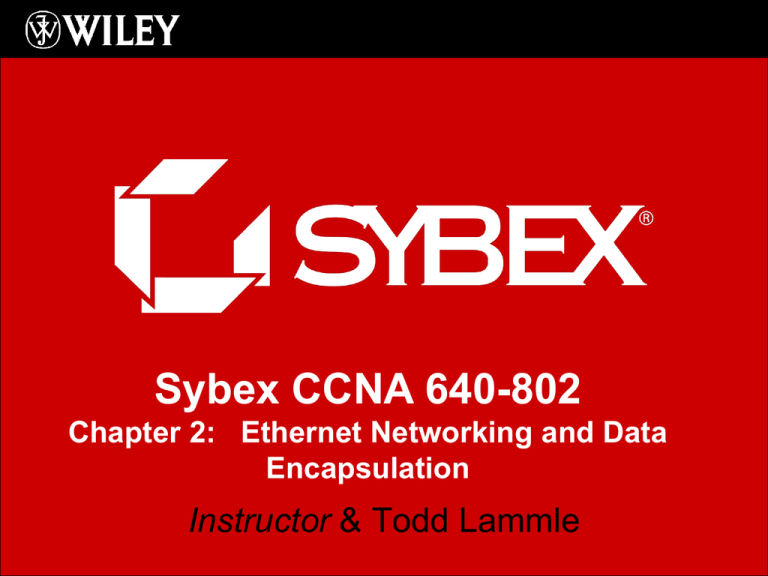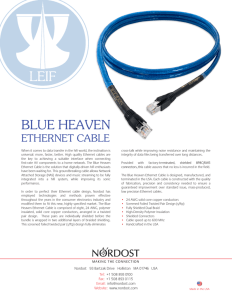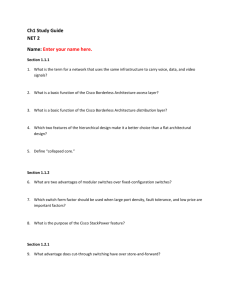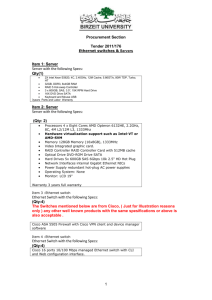Chapter02
advertisement

Sybex CCNA 640-802 Chapter 2: Ethernet Networking and Data Encapsulation Instructor & Todd Lammle Chapter 2 Objectives • The CCNA Topics Covered in this chapter include: – Use the OSI and TCP/IP models and their associated protocols to explain how data flows in a network – Select the appropriate media, cables, ports, and connectors to connect switches to other network devices and hosts – Explain the technology and media access control method for Ethernet networks – Explain network segmentation and basic traffic management concepts – Select the appropriate media, cables, ports, and connectors to connect routers to other network devices and hosts 2 Ethernet Networking • Ethernet is a contention media access method that allows all hosts on a network to share the same bandwidth of a link. • Ethernet is popular because it’s readily scalable, meaning that it’s comparatively easy to integrate new technologies, such as Fast Ethernet and Gigabit Ethernet, into an existing network infrastructure. • It’s also relatively simple to implement in the first place, and with it, troubleshooting is reasonably straightforward. 3 Ethernet Collision Detection CSMA/CD 4 Half and Full Duplex Half-duplex Ethernet is defined in the original 802.3 Ethernet; Cisco says it uses only one wire pair with a digital signal running in both directions on the wire. But full-duplex Ethernet uses two pairs of wires instead of one wire pair like half duplex. And full duplex uses a point-to-point connection between the transmitter of the transmitting device and the receiver of the receiving device. Full-duplex Ethernet can be used in three situations: • With a connection from a switch to a host • With a connection from a switch to a switch • With a connection from a host to a host using a crossover cable 5 Ethernet Addressing The MAC, or hardware, address is a 48-bit (6-byte) address written in a hexadecimal format. 6 Binary Addressing Binary to Decimal Memorization Chart 10000000 128 11000000 192 11100000 224 11110000 240 11111000 248 11111100 252 11111110 254 11111111 255 Conversion Example BINARY 128 64 32 16 8 4 2 1 DECIMAL 10000100 1 0 0 0 0 1 0 0 132 11010010 1 1 0 1 0 0 1 0 210 10111000 1 0 1 1 1 0 0 0 184 10100110 1 0 1 0 0 1 1 0 166 7 Ethernet at the Physical Layer The IEEE 802.3 and original Ethernet Physical layer specifications. 8 Ethernet Cabling Ethernet cabling is an important discussion, especially if you are planning on taking the Cisco exams. Three types of Ethernet cables are available: • Straight-through cable • Crossover cable • Rolled cable We will look at each in the following sections. 9 Straight Through The straight-through cable is used to connect • Host to switch or hub • Router to switch or hub 10 Crossover Cable The crossover cable can be used to connect • Switch to switch • Hub to hub • Host to host • Hub to switch • Router direct to host 11 Rolled Cable Although rolled cable isn’t used to connect any Ethernet connections together, you can use a rolled Ethernet cable to connect a host to a router console serial communication (com) port. 12 Using Hyper Terminal Notice the settings for Hyper Terminal 13 What type of cable is used? 14 What type of cable is used for each connection? 15 Data Encapsulation When a host transmits data across a network to another device, the data goes through encapsulation: • It is wrapped with protocol information at each layer of the OSI model. • Each layer communicates only with its peer layer on the receiving device. 16 Data Encapsulation 17 PDU 18 Port Numbers The Transport layer uses port numbers to define both the virtual circuit and the upper-layer process. 19 Cisco’s Three-Layer Model The following are the three layers and their typical functions: • The core layer: backbone • The distribution layer: routing • The access layer: switching 20 Written Labs and Review Questions – Open your books and go through all the written labs and the review questions. – Review the answers in class. 21





